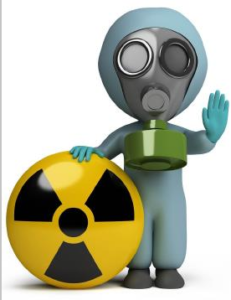
What is Radiation?
Radiation is energy travelling as waves or particles. Ionising radiation has enough energy to ionise (remove an electron from an atom) which can change the chemical composition of the material. Non-ionising radiation has less energy but can still excite molecules and atoms causing them to vibrate faster.
Sometimes electromagnetic radiation is described using its frequency rather than its wavelength. These two characteristics are related.
If we could watch a wave of electromagnetic radiation pass, the wavelength would be the distance between two adjacent wave crests, while the frequency would be the number of wave peaks that pass in a given time. Since electromagnetic radiation travels at a constant speed in a constant environment, radiation with a longer wavelength would have fewer waves passing in a given time (lower frequency) and radiation with a shorter wavelength would have more waves passing in a given time (higher frequency). When wavelength increases, frequency decreases and vice versa.
Non-ionizing radiation versus ionizing radiation
Non-ionising radiation is found at the long wavelength end of the spectrum and may have enough energy to excite molecules and atoms causing them to vibrate faster. Example of non-ionizing radiation source are radio, TV, microwave and etc.
Ionising radiation has more energy than non-ionising radiation; enough to cause chemical changes by breaking chemical bonds. This effect can cause damage to living tissue. Example of ionizing radiation sources are medical X-ray and radioactive sources.
Protection against Ionizing radiation exposure
The guiding principle of radiation safety is “ALARA”. ALARA stands for “as low as reasonably achievable”. To do this, you can use three basic protective measures in radiation safety: time, distance, and shielding.
As ionizing radiation passes through matter, the intensity of the radiation is diminished. Shielding is the placement of an “absorber” between you and the radiation source. An absorber is a material that reduces radiation from the radiation source to you. Alpha, beta, or gamma radiation can all be stopped by different thicknesses of absorbers.
Shielding material can include barrels, boards, vehicles, buildings, gravel, water, lead or whatever else is immediately available.
Ionizing Radiation Safety Solutions
Our ionizing radiation safety solutions can be segregated into 2 categories:
Radiation shielding

We have gained a vast amount of experience in the supply of customized radiation shielding solution according to each customer’s applications, be it in the research, industry, or the healthcare sector.
For instance, are you looking for ways to minimize radiation exposure without the need to lead lined the entire room?
Are you in the healthcare sector and is sick and tired of wearing heavy lead aprons for hours, and wonders if there are lighter radiation protection aprons options available?
Are you a researcher whom would like to start radioactive research in your laboratory, but does not know where to begin?
Radiation monitoring

Three common measurements of radiation are the amount of radioactivity, ambient radiation levels, and radiation dose. But, to get accurate and reliable measurements, we need to have both the right instrument and a trained operator. It is also important to maintain radiation detection equipment to ensure it is working properly.
Would you like to know how much radiation are you exposed to in real time?
Would you like to have the assurance of working in a radiation safe environment, for example, knowing that there is no radioactive contamination or radiation leakage in the room?
Are you concern about the possibility of radiation leakage from X-ray machine?
Leave us your contact information below and we will get back to you soon!
Or Get In Touch With Us Directly:
QT Instruments (S) Pte. Ltd.
Address: 192 Pandan Loop, Singapore 128381
Phone: +65 6303 9833


